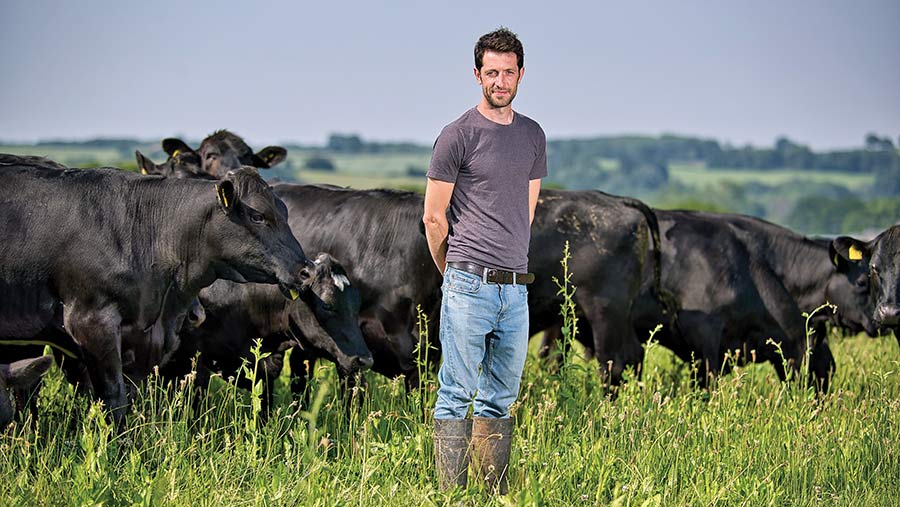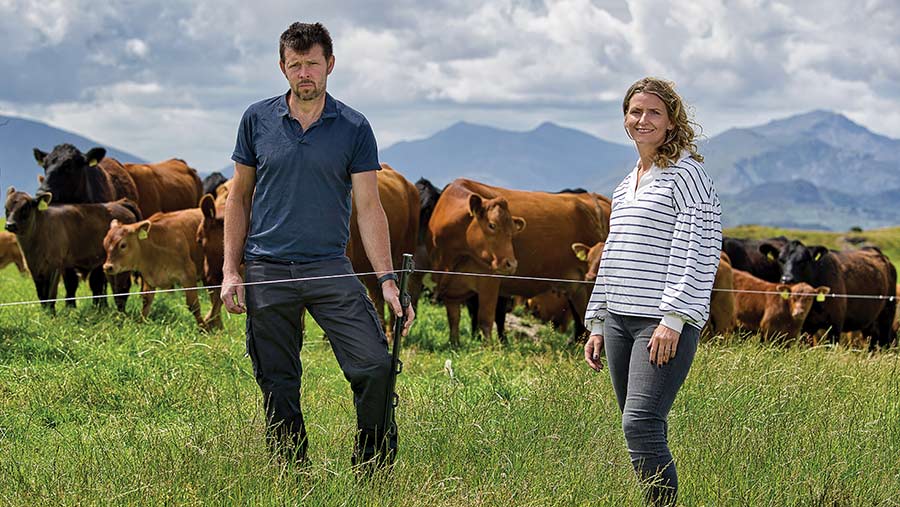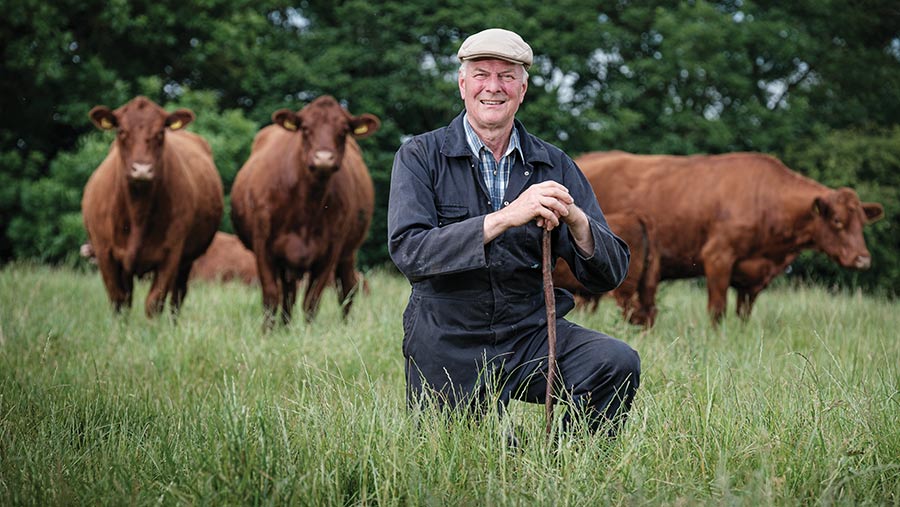Farmers Weekly Awards 2023: Beef Farmer of the Year finalists

Our three finalists have developed their enterprises to improve farm biodiversity, bolster herd health through the use of data and genetics, and extend cow longevity with a focus on easy calving.
See also: See the full 2023 Farmers Weekly Awards shortlist
The finalists:
Ian Farrant
Underley Farm, Herefordshire
Llion and Sian Jones
Moelogan Fawr, Conwy
Terence Pye
Leven Fields Farm, North Yorkshire
The judges:
Simon Cutter
Last year’s winner
Debbie James
Farmers Weekly Welsh correspondent
James Hadwin
Independent beef and sheep consultant and tenant farmer
Ian Farrant
Underley Farm, Herefordshire

Ian Farrant © Richard Stanton
Farm facts
- 202ha (499 acres) owned
- 20ha (49 acres) rented
- 34ha (83 acres) of maize grown for finishing cattle
- 25ha (63 acres) wheat grown and crimped at 30% dry matter
- Farmyard manure fermented as bokashi
- Cattle supplied to Dovecote Park and Grassroots Farming
- Two full-time and one part-time employees
When livestock numbers reached capacity on his available land base, Ian Farrant reassessed the direction of his dairy-to-beef enterprise, asking himself: “What will a successful beef farm look like in 20 years’ time?”
He could continue to expand, buy more feed and improve economies of scale, or re-evaluate his aims.
“My conclusion was that we must be able to look our consumers in the eye and explain why our beef is not only great quality, but also plays a key role in improving soil health, water quality, biodiversity – and even human health,” he says.
Three years on, Ian has developed a system that is less reliant on purchased feed and synthetic fertiliser and targets exceptional growth rates and high profitability.
Performance
Ian grows and fattens about 650 calves a year within a larger, family-run farming business that includes dairying.
The beef enterprise is low-input and grass-based. Angus-crosses have replaced the British Blue-crosses previously fattened – a switch made for economic and sustainability reasons.
“The Angus-crosses require far less concentrates and make better use of grazing,” he says.
“They can potentially finish at grass, saving a fortune, and command a higher price.”
The bulk of calves come from the dairy herd and the remainder from Meadow Quality.
They are on a finishing ration for 45 days, compared with 75 days for the British Blue-crosses.
Although the carcass is 20kg lighter, the volume of concentrates needed to get the animals to a fat cover of 3+/4- is about one-third of what it was.
Cattle are weighed monthly – lifetime daily liveweight gain averages 1.05kg.
Although Ian says he doesn’t hold up this figure as a great indicator of success, he adds: “Striking the best balance between growth rates and cost is the challenge we all face.”
No worming treatments have been given for two years, and a Fecpak camera is now used for sampling; results are available within an hour.
“This has led to a return of dung beetles, especially on the multispecies leys, where the dung is slightly firmer,” says Ian.
Cattle and soil nutrition
Cattle are grazed rotationally with daily moves. Groups of 100-150 are turned onto target covers of 2,900kg/ha dry matter (DM), and exit at a residual of 1,800kg/ha DM. There are also 23ha (57 acres) of multispecies leys.
Ian is a farmer who likes to support decision-making with hard data. In one trial, he grazed 100 cattle aged between seven and eight months on multispecies leys.
They grew 1.12kg/day compared with the 0.9kg/day achieved by animals grazing perennial ryegrass and clover covers.
Some 18ha (45 acres) of intercropped peas and barley are grown as concentrate feed.
Crimped grain from the 2022 harvest analysed at 60% DM, 24% crude protein and metabolisable energy of 13MJ/kg; last year it cost £85/t to produce.
Teamwork
The beef enterprise is part of a larger family partnership that spans three generations.
Each partner is responsible for managing an individual enterprise, making use of a team of farm staff.
“We have a great blend of experience and enthusiasm to call on. Every major decision I make, I must be able to justify to the other partners, which helps limit irrational choices,” he says.
“I always think these awards should be for beef farm of the year, rather than farmer, as having a great team gives me the time and confidence to tackle the bigger issues.”
What the judges say:
Ian’s willingness to adapt and innovate has allowed him to build an admirable business. He has a very clear focus on the future direction of his beef enterprise, tailoring new systems to suit the farm.
Ian Farrant summary
The judges liked
- Excellent, close-knit family farming business
- A strong handle on all aspects of the business
- Strong focus on staff satisfaction
- Opportunity-driven
- Continually trying new things
The numbers
- 100-150 head grazing groups
- 1.05kg daily liveweight gain
- 45-day finishing period
- 1.3% total mortality
- 119kg/ha N applied to grassland
Llion and Sian Jones
Moelogan Fawr, Conwy

Sian and Llion Jones © Richard Stanton
Farm facts
- Closed herd
- Spring calving – heifers from late March and cows from early April, all mostly outdoors
- Calves weaned in mid- to late October – fence line weaning
- Flock of cross-bred Aberfield ewes
- 10ha of new woodland planted in 2018 through the Glastir Woodland Creation Scheme
- Twelve wind turbines
Llion and Sian Jones set themselves a series of goals when they took charge of running the family farm in 2018.
Chief among those were improving the health and genetics of their beef herd and increasing the quality and quantity of grassland produced on a farm that rises to 457m at its highest point.
Five years on and those ambitions are yielding year-on-year gains across the business.
The Joneses have reduced the calving period in their pedigree beef herd from 16 weeks to nine and, as grass yield and quality have increased, so too has the stocking rate – from 501kg/ha to 1,203kg/ha.
Performance
Llion and Sian farm Moelogan Fawr in partnership with Sian’s parents, Robin and Margaret Williams.
The couple were previously tenants of a small National Trust holding, running it as well as taking off-farm jobs.
When Sian’s parents gave them the opportunity to take over the reins of their 344ha (850-acre) upland farm, they embraced the challenge, immersing themselves in learning, collecting data, benchmarking and signing up to projects.
“This has had a big effect on the business, as being involved in projects meant we had advice from experts in the industry to guide us,” says Llion.
Breeding and sales
Their beef breed of choice is the Stabiliser for its fertility, calving ease, compact mature cow size, docility and hardiness.
The closed herd gets one cycle of artificial insemination (AI) – in 2022, 67% of animals were in calf to AI – before home-bred sweeper bulls with high estimated breeding values (EBVs) are turned in.
Heifers are on a forage-only diet and any that don’t achieve the target weight at first service by the beginning of July are not retained.
Breeding for fertility and culling all empties has resulted in a nine-week calving block.
Income is generated from the sale of breeding bulls, cows and heifers sold off the farm through the Stabiliser Breeding Group.
The top 1% of Stabiliser bulls sells for £8,000, but the Joneses work hard to produce the best EBV bulls for reasons beyond sale income.
Llion says: “We want to produce animals that will be profitable for other farmers by surviving off grass alone, being fit and fertile, with good feet, calving ease and temperament.”
DNA samples are taken at birth to verify parentage and for genomic evaluation.
Calves are weighed and scored for temperament, and udders and feet of the dam scored too.
Data are collected at weaning, and animals are scanned for back fat as yearlings, when scrotal measurements are also taken.
Animals that fail to make the grade for breeding are sold as stores at nine or 10 months to a private buyer.
Cattle and soil nutrition
Grazed grass has been grown without artificial fertiliser for two years.
Fields still produce 6,000kg/ha dry matter despite an annual rainfall average of 1,200-1.500mm, the exposed landscape and a short growing season.
Direct drilling is used for reseeding following a brassica crop; this year fodder beet is being grown to extend the grazing season for heifers.
Most of the farm is split into paddocks, accessed by a network of tracks.
Bull calves are fed 4kg concentrates and silage after weaning to achieve peak condition for sale as stores.
Breeding bulls receive 3kg concentrates and silage.
Llion and Sian aim to develop their system by bringing to life ideas that work best for their farm.
“We have a lot we still want to improve, but it is very rewarding to have customers who return to buy breeding animals because others have performed so well,” says Llion.
What the judges say
Llion and Sian are continually striving to be the best at what they do, using the big volume of data they collect to fine-tune their system to optimise cattle performance and welfare.
Llion and Sian Jones summary
The judges liked
- Great awareness of costs, with exceptional measuring and monitoring of data
- Continually driving improvement through benchmarking
- Sustainable and simple farming practices suited to the farm’s location
- Good understanding of the role of grass in farming system
- Focus on the big picture
- Forward thinkers with plans to add value after weaning through collaborative marketing of weaners
- Building a robust and profitable enterprise
The numbers
- 148 cows and heifers
- 360kg heifer breeding target
- 23 months – age at first calving
- 16% replacement rate
- 139 cows and heifers calved in 2022 – only five needed assistance
- 69% of heifers and 87% of cows calved in the first six weeks
Terence Pye
Leven Fields Farm, North Yorkshire

Terrence Pye © Jim Varney
Farm facts
- 84ha (208 acres) owned
- 70 pedigree sucklers cows – 240 animals overall with stock bulls and youngstock
- Age at first calving: 24 months
- Calves in May and June
- Vaccinates for bovine viral diarrhoea and infectious bovine rhinotracheitis
- Breeding stock are sold directly from the farm or at pedigree breed sales
- Mostly Grade 2 heavy clay soils
Suckler beef farmer Terence Pye is a man on a mission. By addressing difficult calvings in his pedigree Salers herd, 98-99% of his heifers and cows now give birth without any assistance.
He reckons it should be the ambition of every suckler farmer to get to this point, not only for the sake of their own business performance, but to help the beef industry overall to play its part in tackling global warming.
“I would argue that achieving 99% unassisted calvings is practical and will deliver a very significant positive effect on emissions,” he suggests.
Performance
Terence is a first-generation farmer who came to farming late after a career as a chemical engineer at ICI.
Together with his wife, Jane, and with help from their daughter, Emma, he has been developing the Rigel pedigree herd since 2015, advancing herd performance every year.
Compared with the UK average of 84% for the weaned calf rate/100 suckler cows put to the bull, the Rigel herd is achieving 92%.
The family have worked closely with their farm vet to raise performance. Together they investigate every death to understand what could be done to avoid a similar mortality in future.
Breeding
Breeding objectives centre on eliminating bad calvings. Longevity is also a strong feature in the herd.
“If cows don’t get to double figures, I feel like I have been done,” Terence says.
He also has a polling breeding programme in response to demand from his customers. It is a herd with high-health status, accredited for bovine viral diarrhoea, at risk level 1 for Johne’s, and free of infectious bovine rhinotracheitis and leptospirosis.
Although the herd is pedigree and run to produce breeding bulls and heifers, it is managed to commercial principles.
The breeding herd is split into four breeding groups, each with a different emphasis on maternal and terminal traits, but with the principal criteria of selection for unassisted calvings. The pelvic area of bulls is also assessed by the farm vet.
Youngstock are weighed at 100-day intervals; heifers must weigh 400kg at 15 months for breeding.
Cattle and soil nutrition
During the grazing season, the breeding herd is grass-fed and moved every two to three days. Over winter, stock are housed and given home-produced silage and bought-in straw.
From weaning to sale, youngstock are grown on a diet of silage and a 16% protein grower pellet, up to a maximum of 8kg/day.
Since 2016, no chemical fertiliser or sprays have been used – only farmyard manure is applied – and this has resulted in improved yields and quality.
Fields that were producing 12 bales/acre are now yielding 16 and the average across the farm in 2023 was 10.1.
Until 2015, much of the farm had been in continuous arable production and this had affected soil fertility. However, since the changes to soil management were introduced, soil quality is recovering.
“Our swards are more drought-resistant and we have a high percentage of clover,” Terence reports.
Ploughing is no longer used for cultivation. “We can grow good crops of grass with direct drilling; we can manage without ploughing,” he says.
The new approach to grassland management is also beneficial to biodiversity.
Returning bird species include curlews, buzzards, barn owls, ducks, moorhens and numerous hedgerow birds.
What the judges say:
“Terence’s tremendous drive and ambition for beef farming are unquestionable, and that extends beyond his own business as he works tirelessly to improve the Saler breed.”
Terence Pye summary
The judges liked
- Herd has high health status
- Focus on breeding a cow with strong maternal characteristics
- Longevity of cows
- Passion for the herd
- Excellent attention to detail in all areas of the business
- Good use of social media for marketing own animals and customers’ ex-breeding bulls
The numbers
- 700kg average mature cow weight
- 70% conception rate
- 365-day calving interval
- 25 bulls a year sold for breeding
- 270-320kg 200-day weight

